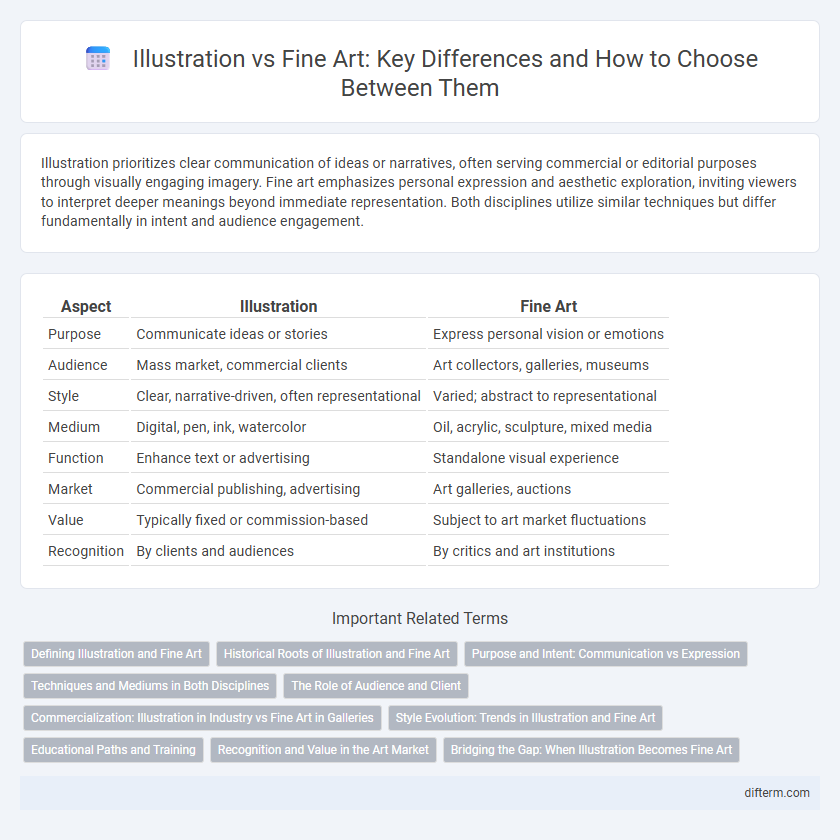Illustration prioritizes clear communication of ideas or narratives, often serving commercial or editorial purposes through visually engaging imagery. Fine art emphasizes personal expression and aesthetic exploration, inviting viewers to interpret deeper meanings beyond immediate representation. Both disciplines utilize similar techniques but differ fundamentally in intent and audience engagement.
Table of Comparison
| Aspect | Illustration | Fine Art |
|---|---|---|
| Purpose | Communicate ideas or stories | Express personal vision or emotions |
| Audience | Mass market, commercial clients | Art collectors, galleries, museums |
| Style | Clear, narrative-driven, often representational | Varied; abstract to representational |
| Medium | Digital, pen, ink, watercolor | Oil, acrylic, sculpture, mixed media |
| Function | Enhance text or advertising | Standalone visual experience |
| Market | Commercial publishing, advertising | Art galleries, auctions |
| Value | Typically fixed or commission-based | Subject to art market fluctuations |
| Recognition | By clients and audiences | By critics and art institutions |
Defining Illustration and Fine Art
Illustration serves a functional purpose, often created to communicate specific ideas or support textual content through visual storytelling, characterized by clarity and accessibility. Fine art prioritizes aesthetic experience and personal expression, emphasizing originality, emotional depth, and conceptual exploration without commercial constraints. The distinction lies in illustration's role as a communicative tool versus fine art's focus on evoking reflection and cultural value.
Historical Roots of Illustration and Fine Art
Illustration originated as a practical tool in printed media during the Renaissance, designed to complement and clarify textual content for a broad audience. Fine art, by contrast, developed from classical traditions emphasizing individual expression, aesthetic value, and the pursuit of beauty, often exhibited in galleries and museums. These divergent historical roots reflect illustration's functional purpose versus fine art's emphasis on conceptual depth and artistic innovation.
Purpose and Intent: Communication vs Expression
Illustration primarily serves the purpose of communication, conveying clear messages and narratives to a specific audience through visual storytelling and design. Fine art emphasizes expression, allowing artists to explore personal emotions, ideas, and abstract concepts without the constraint of direct messaging. This distinction shapes how each art form engages viewers--illustration prioritizes clarity and function, while fine art values subjective interpretation and emotional resonance.
Techniques and Mediums in Both Disciplines
Illustration often employs digital tools, ink, and watercolor to communicate specific narratives or commercial messages, emphasizing clarity and reproduction consistency. Fine art utilizes diverse mediums such as oil paints, sculpture, and mixed media to explore abstract concepts, emotional expression, and unique visual experiences. Techniques in fine art prioritize individual creativity and experimentation, whereas illustration techniques focus on precision and replicability for mass distribution.
The Role of Audience and Client
Illustration primarily serves a functional role, designed to communicate specific messages to a targeted audience or client, often within commercial contexts like advertising, publishing, or media. Fine art emphasizes personal expression and aesthetic experience, appealing broadly to art enthusiasts, collectors, and galleries with the artist's unique vision as the central focus. The audience in illustration guides the creative process through client briefs and market demands, whereas fine art allows for greater interpretive freedom and subjective viewer engagement.
Commercialization: Illustration in Industry vs Fine Art in Galleries
Illustration thrives in commercial industries such as advertising, publishing, and product design, where artwork serves specific client needs and promotes brand messages. Fine art primarily exists within galleries and museums, emphasizing unique creative expression and often sold as one-of-a-kind pieces to collectors. The commercialization of illustration is driven by mass reproducibility and contractual projects, whereas fine art relies on exclusivity and artist reputation.
Style Evolution: Trends in Illustration and Fine Art
Illustration has rapidly evolved from traditional hand-drawn techniques to digitally enhanced styles, emphasizing clarity and commercial appeal, while fine art maintains a focus on experimental and conceptual depth. Trends in illustration prioritize bold lines, vibrant colors, and storytelling, aligning with advertising and media demands, whereas fine art explores abstract forms, texture, and emotional expression to challenge viewers. The convergence of these styles is evident as illustrators incorporate fine art principles, creating hybrid works that reflect contemporary cultural narratives.
Educational Paths and Training
Illustration emphasizes practical skills tailored to commercial applications and often involves specialized programs in graphic design, animation, or visual communication. Fine art education typically centers on conceptual development and traditional techniques, provided through comprehensive studio art degrees and art theory courses. Both paths require rigorous practice, but illustration training prioritizes market-driven projects, whereas fine art focuses on individual expression and critical analysis.
Recognition and Value in the Art Market
Illustration often emphasizes commercial recognition through commissions and mass distribution, leading to consistent demand and broader public visibility. Fine art, by contrast, achieves recognition primarily through gallery exhibitions, art critics, and prestigious auctions, which significantly impact its market value and collector prestige. The art market typically assigns higher monetary value to fine art due to its perceived uniqueness, artistic innovation, and historical significance.
Bridging the Gap: When Illustration Becomes Fine Art
Illustration transcends its commercial roots when it embodies personal expression, complex themes, and innovative techniques, effectively bridging the gap to fine art. Artists like Norman Rockwell and contemporary illustrators elevate their work by combining narrative clarity with aesthetic depth, challenging traditional boundaries. The evolving art market increasingly recognizes illustration's cultural and artistic value, affirming its status within fine art collections and exhibitions.
illustration vs fine art Infographic

 difterm.com
difterm.com